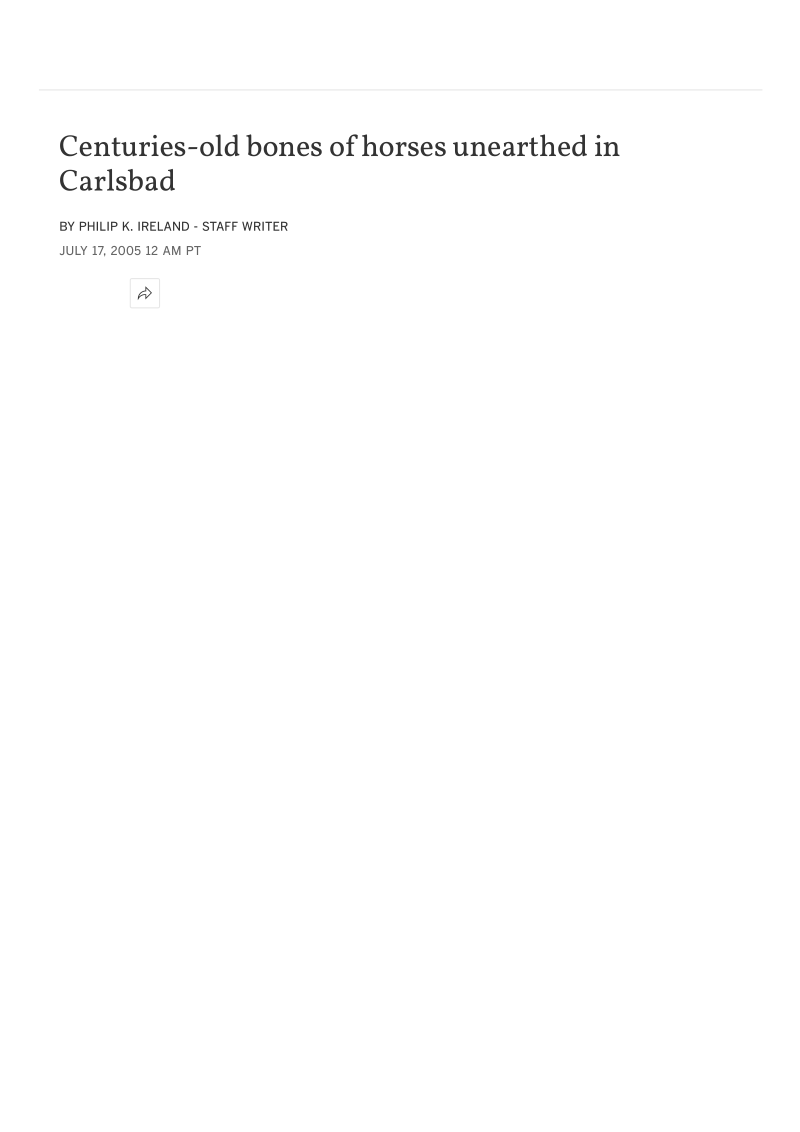Philip Ireland writes about the discovery of the skeleton of a horse that may have lived and died 50 years before Spanish conquered California.
- Type
- News (traditional)
- Source
- Philip Ireland Non-LDS
- Hearsay
- Journalism
- Reference
Philip Ireland, “Centuries-old Bones of Horses Unearthed in Carlsbad [CA],” San Diego Union-Tribune, July 17, 2005, accessed October 16, 2021
- Scribe/Publisher
- San Diego Union-Tribune
- People
- Philip Ireland, Larry Tift, Mark Mojado, Lucas Piek, Bradford Riney
- Audience
- Reading Public
- Transcription
Radiocarbon dating of 340 years, plus or minus 40 years, puts the death of the horse sometime between 1625 and 1705, Mojado said. Therefore, the horses died at least 50 years before San Diego Mission de Alcala, the first of the California missions, was founded in 1769. The other horse and the burro were buried at the same level, suggesting that they were buried about the same time. . . .The radiocarbon date, if corroborated by more elaborate tests, may be remarkable since North American horses were thought to have been extinct by the late Pleistocene era more than 10,000 years ago, said Bradford Riney, a paleontology specialist with the San Diego Natural History Museum.
“That would make (the site) extremely important,” he said Thursday. “It would be an early example of domestication.”
Alternately, Mojado postulated that the horses may have been Spanish in origin, perhaps from an ill-fated exploration that never returned and so was lost to history. Perhaps the lost Spanish explorers offered the horses and donkey to the American Indians as a gift, Mojado said.
“There were no horses here then,” he said. “They didn’t know what a horse or a donkey was. They would have seen them as big deeror antelope.”
As a gift, and an unusual gift at that, the animals most certainly would have been revered, which could explain why they were buried high on a hill in the same way some Indians buried their own, Mojado said.
One horse and the donkey appear to have been buried ritualistically with their heads to the north, faces to the left, and their bodies “flexed” in the fetal position, an American Indian method of burial. The newly discovered horse, its ocher-colored bones already fading to yellow from exposure to sun and air, was not similarly posed.
Researchers said they know horses were deliberately buried because they can see definite lines where someone cut into the shell layers to dig a burial pit.
“I’ve been doing this for 16 years and I’ve never seen anything like it,” Tift said.
The bones show no signs of cutting, splitting or crushing that would indicate a violent death, Piek said. Researchers see no signs the horses were butchered for meat.
- Citations in Mormonr Qnas
The B. H. Roberts Foundation is not owned by, operated by, or affiliated with the Church of Jesus Christ of Latter-day Saints.

